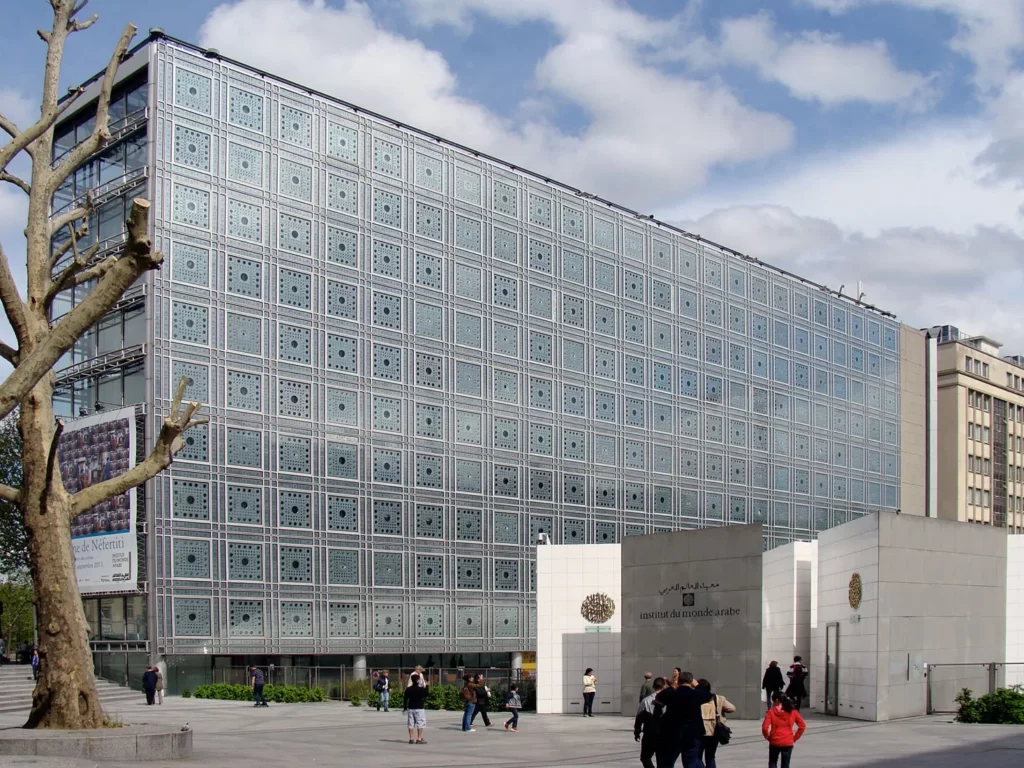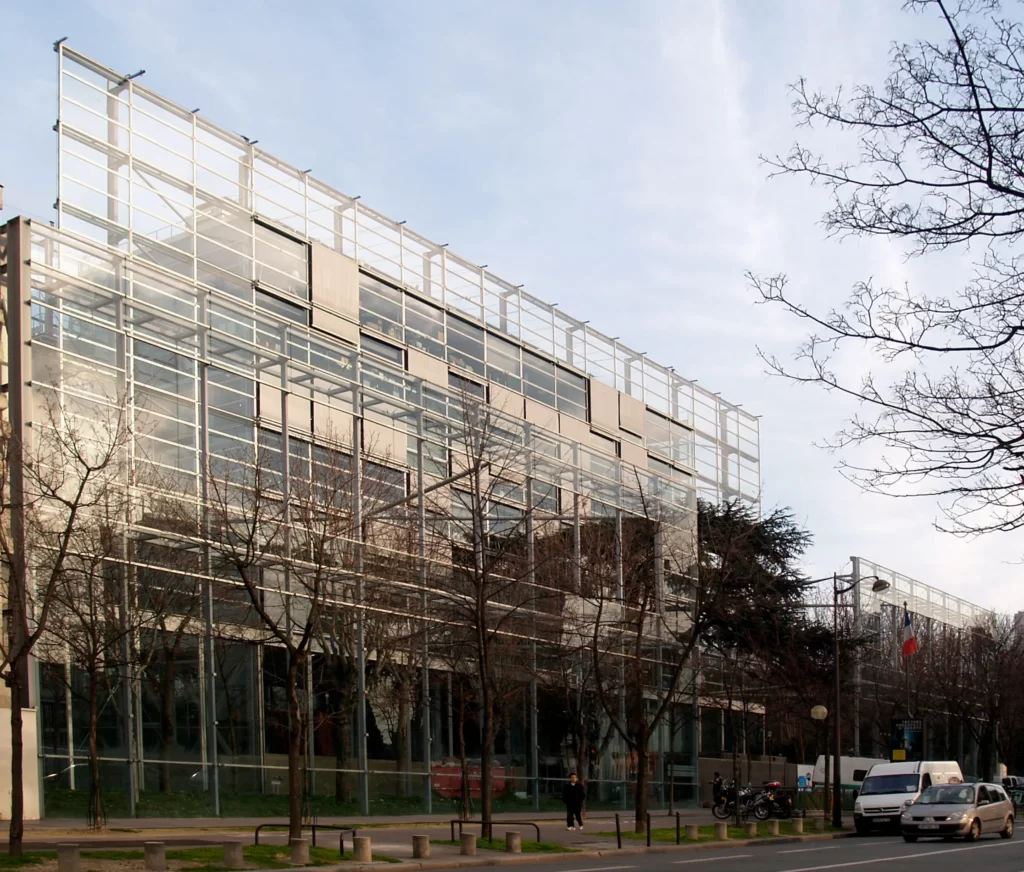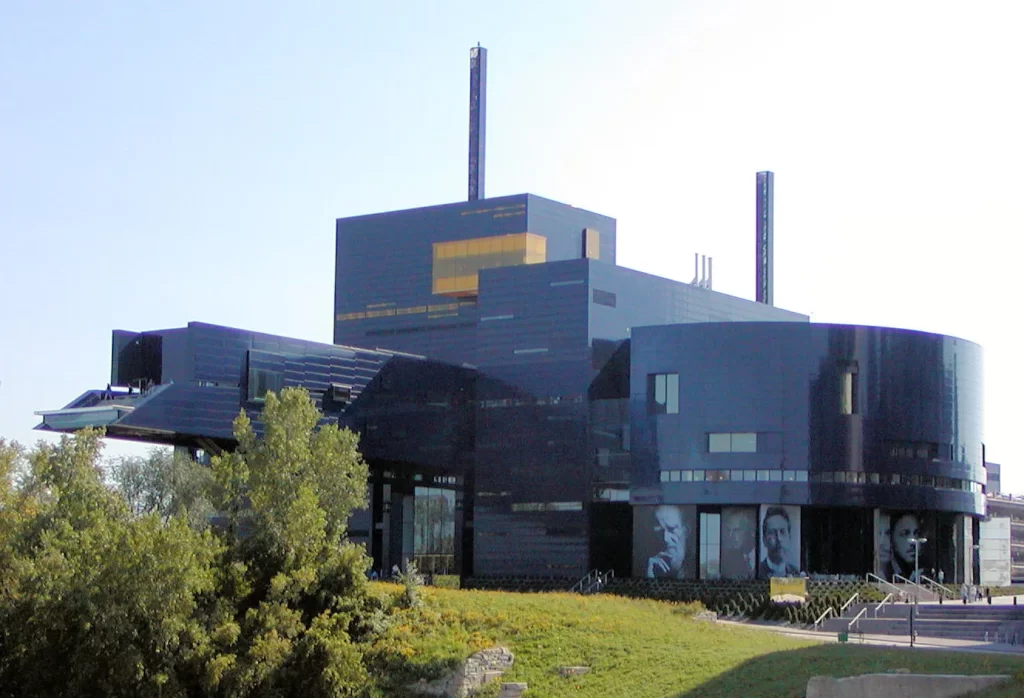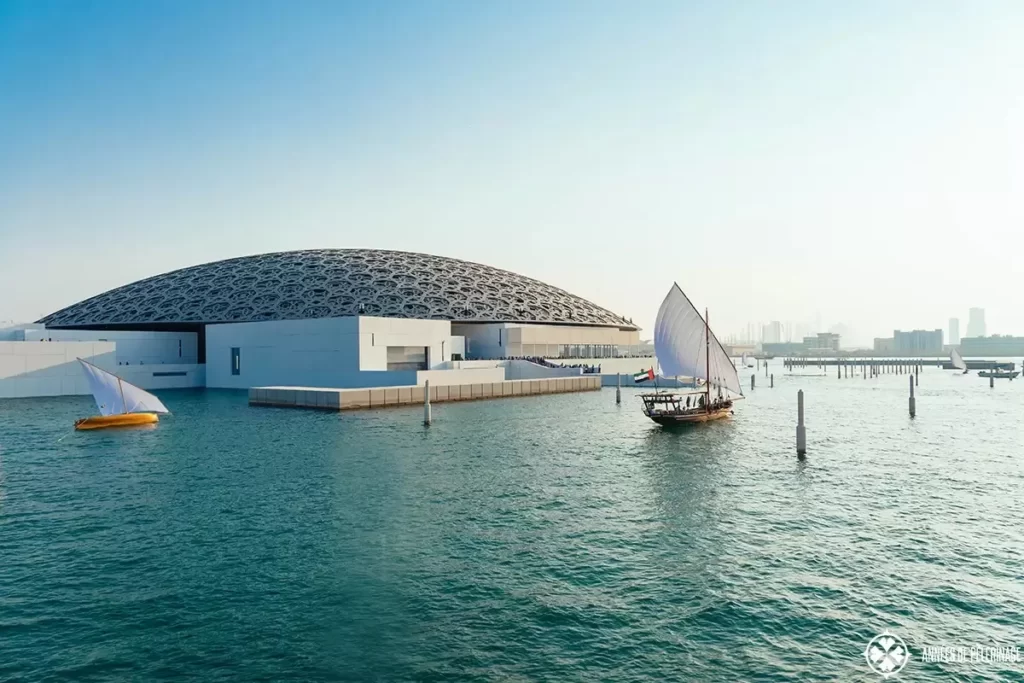If you want to know about the staircase design or landscape garden or requirements for disabled persons in a building, please click the link.
Introduction
Jean Nouvel is a French architect known for his innovative and experimental approach to design. He was born on August 12, 1945, in Fumel, France, and studied architecture at the École des Beaux-Arts in Paris. He worked for a number of different architects and firms in France before establishing his own firm, Ateliers Jean Nouvel, in 1976.

Nouvel’s work is characterized by a bold and experimental use of materials, innovative structural solutions, and a focus on light and space. He has designed a wide range of projects, including cultural centers, museums, hotels, office buildings, and residential complexes.
Some of his most notable works include the Arab World Institute in Paris, the Guthrie Theater in Minneapolis, and the Louvre Abu Dhabi.

Nouvel’s work has been widely recognized and awarded, with honors including the Pritzker Architecture Prize, the Royal Institute of British Architects’ Royal Gold Medal, and the Wolf Prize in Arts.
His work has had a significant impact on the world of architecture, pushing boundaries and inspiring other architects to think creatively and experimentally. He is considered one of the most important and influential architects of our time.
1) Early Life and Education of Jean Nouvel
i) Childhood and early influences:
Jean Nouvel grew up in a family of educators in the southwestern part of France. His mother was a schoolteacher and his father was the director of a vocational school.
As a child, Nouvel was fascinated by the built environment and spent much of his time drawing and observing buildings. His father also introduced him to the world of aviation, which would later inspire some of Nouvel’s work in architecture.
ii) Education and training in architecture:
After completing his secondary education, Nouvel went on to study architecture at the École des Beaux-Arts in Paris. He graduated in 1972 and went on to work for several prominent architects in France, including Claude Parent and Paul Virilio.
iii) Early works and collaborations:
Nouvel’s early works were marked by a focus on experimental and innovative designs. One of his first major collaborations was with French artist Pierre Alechinsky on the renovation of a building in Brussels, which featured a striking façade made of metal and glass.
In the 1980s, Nouvel gained international recognition for his work on the Arab World Institute in Paris, which features a unique façade made of metal and glass that references traditional Arabic architecture. He also collaborated with fashion designer Yves Saint Laurent on the design of the Yves Saint Laurent Museum in Marrakech.
Nouvel’s early works and collaborations set the stage for his later, more iconic projects, and established him as a leading figure in the world of architecture.
2) Architectural Style and Philosophy of Jean Nouvel
i) Overview of his architectural style:
Jean Nouvel’s architectural style is characterized by a bold and innovative use of materials, a focus on light and space, and a willingness to push boundaries and experiment with new ideas. His designs often incorporate unusual forms and shapes, as well as a range of materials and textures.
Key design elements and techniques used by Jean Nouvel: Some of the key design elements and techniques used by Jean Nouvel include:
- Use of light: Nouvel is known for his innovative use of light, which he often employs to create dramatic effects and highlight different aspects of his designs.
- Integration with the surrounding environment: Nouvel’s designs often incorporate elements of the surrounding landscape or built environment, creating a sense of continuity and connection with the surrounding context.
- Experimentation with materials: Nouvel is known for his use of a wide range of materials, including glass, metal, concrete, and wood. He often combines these materials in unexpected ways to create unique and striking designs.
- Attention to detail: Nouvel is meticulous in his attention to detail, ensuring that every aspect of his designs is carefully considered and executed to perfection.
ii) Philosophical approach to architecture and design:
Nouvel’s philosophical approach to architecture and design is based on a belief in the power of architecture to shape our experience of the world around us.
He sees architecture as a way of creating meaning and enriching our lives, and he is committed to pushing boundaries and challenging conventional thinking in order to create designs that are truly innovative and inspiring.
3) Major Works by Jean Nouvel
Overview of some of his most notable works:
i) Arab World Institute, Paris:

Completed in 1987, the Arab World Institute is a cultural center and museum that features a striking façade made of metal and glass, inspired by traditional Arabic architecture. The building also incorporates a range of innovative design features, such as a movable screen that adjusts to control the amount of light entering the building.
The impact of the Arab World Institute on the world of architecture has been significant, with its innovative design and bold use of materials inspiring many other architects to experiment with new forms and techniques.
ii) Cartier Foundation for Contemporary Art, Paris:

Completed in 1994, the Cartier Foundation for Contemporary Art is a museum and cultural center that features a unique glass and steel structure that appears to float above the surrounding landscape. The building also incorporates a range of sustainable design features, such as natural ventilation and a green roof.
The impact of the Cartier Foundation on the world of architecture has been significant, with its innovative design and sustainable features inspiring many other architects to think creatively about how buildings can interact with their environment.
iii) Guthrie Theater, Minneapolis:

Completed in 2006, the Guthrie Theater is a performing arts center that features a bold and innovative design, including a cantilevered bridge that provides stunning views of the surrounding area. The building also incorporates a range of sustainable design features, such as natural ventilation and a green roof.
The impact of the Guthrie Theater on the world of architecture has been significant, with its innovative design and use of sustainable features inspiring many other architects to think creatively about how buildings can enhance the cultural life of a community.
iv) Louvre Abu Dhabi, Abu Dhabi:

Completed in 2017, the Louvre Abu Dhabi is a museum and cultural center that features a stunning design inspired by traditional Arabic architecture. The building incorporates a range of innovative design features, such as a massive dome that filters sunlight to create a unique and immersive visitor experience.
The impact of the Louvre Abu Dhabi on the world of architecture has been significant, with its innovative design and use of traditional materials and forms inspiring many other architects to think creatively about how buildings can incorporate elements of local culture and history.
Discussion of the impact of each project on the world of architecture
Jean Nouvel’s most notable works have had a significant impact on the world of architecture, inspiring other architects to think creatively and experimentally.
The innovative design and bold use of materials in the Arab World Institute, for example, helped to push the boundaries of what was possible in architecture, while the sustainable features and integration with the surrounding landscape in the Cartier Foundation helped to inspire a new wave of environmentally conscious design.
Similarly, the Guthrie Theater and Louvre Abu Dhabi have both had a profound impact on the world of architecture, inspiring other architects to think creatively about how buildings can enhance cultural life and create immersive, meaningful experiences for visitors.
Overall, Jean Nouvel’s work has helped to shape the direction of contemporary architecture, and continues to inspire new generations of architects and designers.
4) Awards and Recognitions Received by Jean Nouvel
Overview of major awards and recognitions received by Jean Nouvel:
- Pritzker Architecture Prize (2008): The Pritzker Architecture Prize is one of the most prestigious awards in the field of architecture, and is often referred to as the “Nobel Prize of architecture”. Nouvel was awarded the prize in recognition of his innovative and influential designs, as well as his impact on the world of architecture.
- RIBA Royal Gold Medal (2001): The Royal Gold Medal is awarded by the Royal Institute of British Architects (RIBA) to individuals or groups who have had a significant impact on the field of architecture. Nouvel was awarded the medal in recognition of his contributions to the field of architecture, particularly his innovative and experimental designs.
- Wolf Prize in Arts (2005): The Wolf Prize in Arts is awarded annually to individuals who have made significant contributions to the arts. Nouvel was awarded the prize in recognition of his innovative and groundbreaking designs, which have had a profound impact on the world of architecture.
- Praemium Imperiale (2001): The Praemium Imperiale is an international art prize awarded by the Japan Art Association to individuals who have made significant contributions to the arts. Nouvel was awarded the prize in recognition of his innovative and experimental designs, which have helped to push the boundaries of what is possible in architecture.
Discussion of the significance of each award and recognition
The awards and recognitions received by Jean Nouvel are a testament to his significant contributions to the field of architecture. The Pritzker Architecture Prize, in particular, is widely regarded as the highest honor in the field of architecture, and is awarded to individuals who have had a significant impact on the field.
Similarly, the RIBA Royal Gold Medal and the Praemium Imperiale are both prestigious awards that recognize individuals who have made significant contributions to the arts. The Wolf Prize in Arts is also a significant recognition of Nouvel’s contributions to the field of architecture, as well as his impact on the broader arts community.
Overall, the awards and recognitions received by Jean Nouvel are a testament to his innovative and experimental approach to architecture, as well as his significant impact on the world of architecture. They also serve to inspire future generations of architects and designers, and to encourage continued experimentation and innovation in the field of architecture.
5) Jean Nouvel’s Impact on the World of Architecture
i) Discussion of his contributions to the field of architecture:
Jean Nouvel’s contributions to the field of architecture are significant and far-reaching. He is known for his innovative and experimental designs, which challenge traditional notions of architecture and push the boundaries of what is possible. His work has been described as “intellectual” and “conceptual”, with a focus on creating spaces that are both functional and aesthetically pleasing.
One of Nouvel’s most significant contributions to the field of architecture is his approach to designing buildings that respond to their surrounding environment. He is known for his ability to create buildings that seamlessly blend into their surroundings, while also incorporating unique design elements that make them stand out.
Another important contribution of Nouvel’s is his use of light and shadow in his designs. He is known for creating buildings that incorporate intricate and complex lighting systems, which help to create a sense of drama and atmosphere within the space.
Finally, Nouvel’s approach to sustainability and energy efficiency is also significant. He is known for incorporating sustainable design features into his buildings, such as green roofs, natural ventilation systems, and renewable energy sources.
ii) Influence on other architects and designers:
Jean Nouvel’s innovative approach to architecture has had a significant influence on other architects and designers around the world. His use of light and shadow, as well as his focus on sustainability and energy efficiency, has inspired many other architects to incorporate similar features into their designs.
Nouvel’s approach to designing buildings that respond to their surrounding environment has also had a significant impact on the field of architecture. Many other architects have been inspired by his ability to seamlessly blend buildings into their surroundings, while also incorporating unique design elements.
Finally, Nouvel’s use of innovative materials and construction techniques has also inspired other architects and designers to experiment with new materials and methods of construction.
iv) Discussion of the legacy of Jean Nouvel’s work:
Jean Nouvel’s legacy in the field of architecture is significant and far-reaching. His innovative and experimental approach to architecture has helped to push the boundaries of what is possible, and has inspired many other architects and designers to take a similar approach.
Nouvel’s focus on sustainability and energy efficiency has also helped to raise awareness of these important issues within the field of architecture, and has inspired many other architects to incorporate sustainable design features into their buildings.
Finally, Nouvel’s use of light and shadow, as well as his ability to create buildings that respond to their surrounding environment, has helped to create a new paradigm for architecture that is focused on creating spaces that are both functional and aesthetically pleasing.
Overall, Jean Nouvel’s legacy in the field of architecture is significant and far-reaching, and his innovative and experimental approach to design continues to inspire architects and designers around the world.
6) Jean Nouvel’s Current and Future Projects
i) Overview of current and future projects by Jean Nouvel:
Jean Nouvel is currently working on a number of high-profile projects around the world, as well as several projects that are still in the planning stages. Some of his current and future projects include:
- National Art Museum of China: Nouvel has been commissioned to design the new National Art Museum of China in Beijing. The museum will be one of the largest in the world, and will feature a design that incorporates traditional Chinese architectural elements.

- La Samaritaine: Located in the heart of Paris, La Samaritaine is a historic department store that has been closed for over a decade. Nouvel is currently overseeing a major renovation of the building, which will transform it into a mixed-use development featuring a hotel, apartments, retail space, and a cultural center.

- 53W53: This luxury residential tower is located in Midtown Manhattan, and features a design that incorporates a unique series of setbacks and cantilevers. The building is set to become one of the most iconic buildings in the New York City skyline.

- Louvre Abu Dhabi: Opened in 2017, the Louvre Abu Dhabi is a cultural institution that features a design that incorporates traditional Islamic architectural elements. The museum is set to become a major cultural destination in the Middle East.

ii) Discussion of the design concept and features of each project
National Art Museum of China: The design of the National Art Museum of China is still in development, but it is expected to incorporate traditional Chinese architectural elements, such as a courtyard and a sloping roof. The museum will feature exhibition space for traditional Chinese art, as well as contemporary art from around the world.
La Samaritaine: The renovation of La Samaritaine will transform the historic department store into a mixed-use development that incorporates a hotel, apartments, retail space, and a cultural center. The design features a glass façade that will offer stunning views of the Seine River and the Paris skyline.
53W53: The design of 53W53 incorporates a unique series of setbacks and cantilevers that create a distinctive silhouette in the New York City skyline. The building will feature luxury residential units, as well as a new location for the Museum of Modern Art.
Louvre Abu Dhabi: The Louvre Abu Dhabi features a design that incorporates traditional Islamic architectural elements, such as a dome that is made up of thousands of intricate metal stars. The museum’s collection includes works from around the world, from ancient artifacts to contemporary art.
iv) Potential impact of each project on the world of architecture:
The National Art Museum of China is set to become one of the largest and most important cultural institutions in the world, and Nouvel’s design is sure to draw attention to the museum’s collection and architecture. The incorporation of traditional Chinese architectural elements will also help to promote a greater appreciation for Chinese culture and art.
The renovation of La Samaritaine is expected to transform the building into a major cultural destination in Paris, and the glass façade is sure to become an iconic feature of the city’s skyline. The mixed-use development will also provide much-needed housing and retail space in the heart of Paris.
53W53 is set to become one of the most iconic buildings in the New York City skyline, and Nouvel’s unique design is sure to inspire other architects and designers to experiment with new forms and shapes. The Museum of Modern Art’s new location within the building will also help to promote a greater appreciation for contemporary art.
The Louvre Abu Dhabi is already having a significant impact on the world of architecture, with its unique design drawing visitors from around the world. The museum is helping to promote a greater appreciation for art and culture in the Middle East, and its innovative design is sure to inspire other architects and designers to experiment with new materials
7) Conclusion
Recap of key points:
- Jean Nouvel is a world-renowned architect known for his innovative and bold designs.
- He was born in France in 1945 and began his career in architecture in the 1970s.
- His early works focused on experimental designs that challenged traditional architectural conventions.
- Nouvel is known for his use of unique materials and innovative design elements, such as his use of color, light, and shadow.
- Some of his most notable works include the Institut du Monde Arabe in Paris, the Torre Agbar in Barcelona, and the Louvre Abu Dhabi.
- He has won numerous awards and recognitions for his work, including the Pritzker Architecture Prize in 2008.
- Nouvel’s legacy has had a lasting impact on the world of architecture and design, with his innovative designs inspiring countless other architects and designers.
Discussion of the lasting impact of Jean Nouvel’s work on architecture and design
Jean Nouvel’s work has had a significant and lasting impact on the world of architecture and design. His innovative designs and use of unique materials have inspired countless other architects and designers to experiment with new forms and shapes.
Nouvel’s emphasis on the use of light and shadow has also influenced many other architects, who have incorporated similar techniques into their own designs. His use of color has also been particularly influential, with many architects and designers incorporating bold and vibrant colors into their work in ways that were not previously common in the field.
Overall, Jean Nouvel’s legacy is one of innovation, creativity, and a willingness to push the boundaries of what is possible in architecture and design. His influence can be seen in the work of countless other architects and designers, and his impact on the field is sure to be felt for many years to come.